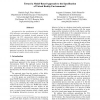Free Online Productivity Tools
i2Speak
i2Symbol
i2OCR
iTex2Img
iWeb2Print
iWeb2Shot
i2Type
iPdf2Split
iPdf2Merge
i2Bopomofo
i2Arabic
i2Style
i2Image
i2PDF
iLatex2Rtf
Sci2ools
MSE
2002
IEEE
2002
IEEE
Toward a Model-Based Approach to the Specification of Virtual Reality Environments
An approach to the specification of a Virtual Reality (VR) interactive environment is presented, which merges and generalizes two methods recently proposed in the literature: the PCL characteristic pattern approach to WIMP system design and the Interaction Locus approach to interactive navigation in 3-D virtual spaces. The merging of the two points of view allows the refinement of the model of interaction of a user with a virtual environment and leads to the definition of “real” and “virtual” characteristic pattern, which the discussion shows to be an important concept for the designer to properly undertake the design of complex virtual reality systems.
| Added | 15 Jul 2010 |
| Updated | 15 Jul 2010 |
| Type | Conference |
| Year | 2002 |
| Where | MSE |
| Authors | Daniela Fogli, Piero Mussio, Augusto Celentano, Fabio Pittarello |
Comments (0)

